Eleanor Brickdale Fortescue - 1871-1945

Eleanor Fortescue-Brickdale was born in London in 1872, the daughter of barrister Matthew Fortescue-Brickdale. She attended the Crystal Palace School of Art and later between 1897-1900 Eleanor studied at the Royal Academy Schools. Her first exhibit at the Royal Academy was a black and white piece in 1896 and she went on to exhibit at Royal Watercolor Society.
During her lifetime, Brickdale became well respected as an illustrator which was an unusual accomplishment for a women of the day. Her earliest were works done in a simple manner in pen, and she did not begin to add color until several years into her career. From 1902 Eleanor Fortescue-Brickdale worked both as a painter and illustrator of fine books, among them Alfred Tennyson's Poems in 1905 and Robert Browning's Pippa Passes in 1908. She was the first female member of the Institute of Painters in Oils in 1902, a member of the RWS and also taught at the Byam Shaw School of Arts. Starting in 1901 she held a series of exhibitions entitled Such Stuff as Dreams are Made Of done in watercolor and gouache. One painting included in the show was In the Springtime.
Though she continued to paint in Pre-Raphaelite methods well into the twentieth century with it's attention to detail and similar subwject matter, later in life Fortescue-Brickdale expanded her style to designing stained glass. She donated her work to churches, some of which may still be seen in Bristol Cathedral today. Eleanor Fortescue-Brickdale died in London of a stroke in 1945.
Museums: Eleanor Fortescue-Brickdale may be found at Walker Art Gallery or the Birmingham City Museum and Art Gallery.
Pre-Raphaelite Artists
Brickdale (1871-1945)
Eleanor Fortescue Brickdale
"The Lover's World"
Eleanor Fortescue Brickdale
"The Uninvited Guest"
1906
Arthurian and Medieval Images
Here are a number of Pre-Raphaelite versions of Arthurian material and other medieval motifs. On the "Medieval" page are some historically medieval artworks and images by Raphael and Botticelli, for comparison. Although the Pre-Raphaelites had a problem with Raphael, Burne-Jones nevertheless shows the infleunce of Raphael, as well as Botticelli. The influence is there in other Pre-Raphaelite artists as well.
Because this page is already long and takes a while to download, I have placed the remaining Arthurian and medieval images in a second page, titled "Arthurian images 2." The painting above is The Uninvited Guest by Eleanor Fortesque Brickdale, 1906. It is discussed on the Arthurian images 2 page. The final set of Arthurian images you can check out is on the "Beardsley" page.
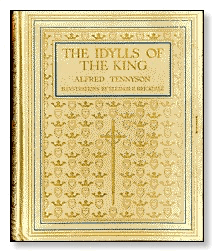
Eleanor Fortescue Brickdale Idylls of the King . . . . . . . $550
By Alfred Lord Tennyson; Hodder and Stoughton. nd First limited edition.
Folio. Very good - minor overall dusting to vellum, free EPs are browned, ties missing, otherwise fine. #200 of only 350 copies signed by Brickdale.
173pp. 21 tipped-in color plates (with printed tissue guards) of beautiful queens and maidens (Enid, Vivien, Elaine) in EFB's fine Pre-Raphaelite style.
Plates are tipped onto gilt-bordered pages. Brickdale is at her finest with this same subject matter favored by Rossetti and Burne-Jones.
Pre-Raphaelite Women Artists
by Jan Marsh, Pamela Gerrish Nunn
Book Description
The work of the Pre-Raphaelite Brotherhood and their followers is enduringly popular and correspondingly familiar to a wide public.
Works by women artists within the Pre-Raphaelite style have, however, largely been forgotten and ignored in the history of the movement.
This book, published to accompany an exhibition in Manchester, England, brings together paintings,
drawings, photographs, and other works that women contributed to the Pre-Raphaelite movement.
Many are reproduced and documented here for the first time.
Spanning three generations from the 1840s to the early 1900s, the artists include Barbara Bodichon, Anna Howitt, Rosa Brett, Anna Blunden, Jane Benham Hay, Joanna Boyce, Elizabeth Siddal,
Rebecca Solomon, Emma Sandys, Julia Margaret Cameron, Lucy and Catherine Madox Brown, Marie Spartali Stillman, Maria Zambaco,
Francesca Alexander, Evelyn De Morgan, Kate Bunce, Marianne Stokes, Christina Herringham, and Eleanor Fortescue Brickdale.
Their works demonstrate that Pre-Raphaelitism is a broader historical movement than has previously been recognized and that women were active in all its phases.
Their re-inclusion in Pre-Raphaelite history will redefine its scope, concerns, and achievements,
as well as restore a wealth of neglected works to public attention. --This text refers to the Paperback edition.
The Idylls of the King .
.  .
. 
 .
. 
 .
. 

Eleanor Fortescue-Brickdale illustrations from
Alfred, Lord Tennyson's
Book on Knights and Knighthood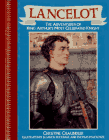
Lancelot : The Adventures & Romances;
Christine Chaundler, Eleanor Fortesque-Brickdale;
Hardcover; $12.99;
A collection of tales featuring the bravest knight in King Arthur's Court.
Eleanor Fortescue Brickdale
"The Guardian Angel", 1910,
Photo: Christies from: Women Artists and the Pre-Raphaelite Movement
by Jan Marsh and Pamela Gerrish Nunn.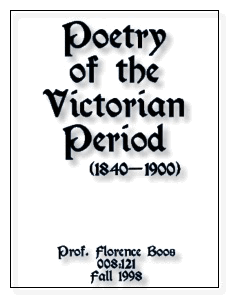
Students examine a portion of the wide range of poetry written during this period: poetry remarkable for its linguistic virtuosity (G.M. Hopkins); narrative complexity (Elizabeth Barrett Browning); feminist agenda (Amy Levy); psychological intensity (William Morris); unconventional eroticism (Algernon Swinburne); sensuous charm (Alfred Tennyson); and intricate humor (Robert Browning). The class discusses poetry of celebration, consolation, amusement, and reflection written during the high-Victorian period and the fin de siecle by women and by men, by members of several classes, and by defenders of different social and religious faiths. Students also consider issues of poetic language, rhetoric, and genre, and the social context and audience of all these works. The instructor offers information about the period, the individual author's lives and the Victorian literary marketplace, and many examples of Victorian visual arts. Class focus is on discussion, so attendance is essential, and affects final grades. Students are expected to submit eighteen pages of written work, which may be divided into two or three shorter essays or a longer one according to student preferences.

 .
.  .
.  .
.  .
. 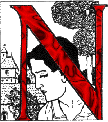
 .
.  .
.  .
.  .
.  .
.  .
. 
WOMEN ARTISTS IN HISTORY
We're using this space to showcase the work of women artists down through the centuries. Over time we will do our best to make this list comprehensive. If you have a famous artist to recommend, please send us mail.
We would like to create a network of women who are interested in the work of women artists. Our dream is that eventually all the women on our list will have their own web page. If any of these women strike your fancy and you decide to devote a web page to their work, please let us know and we will link our page to yours.
…
Nineteenth Century
…
- Susan Macdowell Eakins (1851-1938)
- Elizabeth A. Armstrong Forbes (1859-1912)
- Eleanor Fortescue-Brickdale
- Eva Gonzalès (1849-1883)
- Ann Hall (1792-1863)
- Antoinette-Cecile Hortense Haudebourt-Lescot (1784-1845)
- Claude Raguet Hirst (1855-1942)
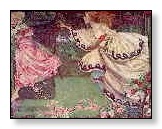
Youth and the Lady
Eleanor Fortescue Brickdale was an oil and watercolour painter, a designer of stained glass, and a book illustrator. She studied at the Crystal Palace School of Art under Herbert Bone from 1889, then at the RA Schools, showing oils and watercolours in the Exhibitions from 1896 and achieving early recognition in The Studio, and having three solo exhibitions at the Pre-Raphaelite dedicated Dowdeswell Gallery in the 1900s. She became RWS in 1919. Her London studio was very close to Leighton House. Her output is mixed - some pictures rather symbolist, others sentimental, and her style varies from rather wishy-washy to very detailed. Often it shows the influence of her friend Byam Shaw, who founded a school of painting where Fortescue Brickdale later taught. Her best pictures have jewel-like colours and Pre-Raphaelite girls in ornate classical garb. Often her paintings show just one or two figures with accoutrements indicative of subject.
As a book illustrator, Brickdale had a large output in the early years of this century, working on children's books and poetry (e.g. Tennyson, Browning) and song books.
It is hard to find pictures by Brickdale on display, but there is at least one at the Russell-Cotes Museum, and another (The Forerunner of 1920) at the Lady Lever Gallery. A fairy picture, called The Lover's World (1905), is owned by the Bristol gallery, and with its tiny figures seems influenced by Walter Crane's The Mower.

